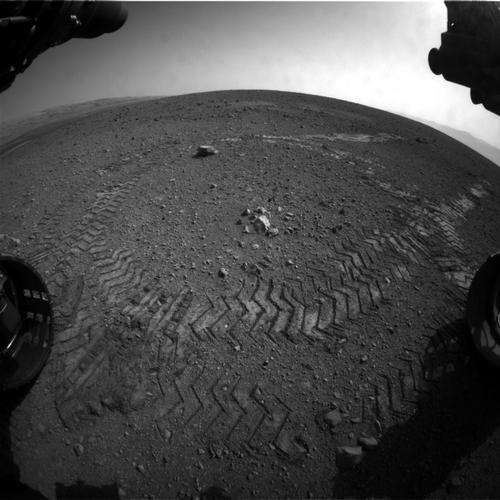 |
This 360-degree panorama shows evidence of a successful first test drive for NASA's Curiosity rover. On Aug. 22, 2012, the rover made its first move, going forward about 15 feet (4.5 meters), rotating 120 degrees and then reversing about 8 feet (2.5 meters). Curiosity is about 20 feet (6 meters) from its landing site, now named Bradbury Landing.
Visible in the image are the rover's first track marks. A small 3.5-inch (9-centimeter) rock can be seen where the drive began, which engineers say was partially under one of the rear wheels. Scour marks left by the rover's descent stage during landing can be seen to the left and right of the wheel tracks. The lower slopes of Mount Sharp are visible at the top of the picture, near the center.
This mosaic from the rover's Navigation camera is made up of 23 full-resolution frames, displayed in a cylindrical projection.
Image credit: NASA/JPL-Caltech
|
PASADENA, Calif. -- NASA's Mars rover Curiosity has begun driving from its landing site, which scientists announced today they have named for the late author Ray Bradbury.
Making its first movement on the Martian surface, Curiosity's drive combined forward, turn and reverse segments. This placed the rover roughly 20 feet (6 meters) from the spot where it landed 16 days ago.
NASA has approved the Curiosity science team's choice to name the landing ground for the influential author, who was born 92 years ago today and died this year. The location where Curiosity touched down is now called Bradbury Landing.
 |
| View from Hazard Avoidance camera Image Credit: NASA/JPL-Caltech |
 |
| Curiosity`s first drive tracks on Bradbury Landing, Mars. Image credit: NASA/JPL-Caltech |
"We have a fully functioning mobility system with lots of amazing exploration ahead," Heverly said.
Curiosity will spend several more days of working beside Bradbury Landing, performing instrument checks and studying the surroundings, before embarking toward its first driving destination approximately 1,300 feet (400 meters) to the east-southeast.
"Curiosity is a much more complex vehicle than earlier Mars rovers. The testing and characterization activities during the initial weeks of the mission lay important groundwork for operating our precious national resource with appropriate care," said Curiosity Project Manager Pete Theisinger of JPL. "Sixteen days in, we are making excellent progress."
The science team has begun pointing instruments on the rover's mast for investigating specific targets of interest near and far. The Chemistry and Camera (ChemCam) instrument used a laser...
(click here to continue reading the article at NASA)
More information about Curiosity is online at:
http://www.nasa.gov/msl and http://mars.jpl.nasa.gov/msl .
credit:
Guy Webster/D.C. Agle 818-354-6278/818-393-9011
Jet Propulsion Laboratory, Pasadena, Calif.
Guy.webster@jpl.nasa.gov / agle@jpl.nasa.gov
Dwayne Brown 202-358-1726
NASA Headquarters, Washington
Dwayne.c.brown@nasa.gov




















































































































No comments:
Post a Comment